|
|

The following information is provided in this chapter:
For complete physical specifications, see "Specifications."
Before unpacking the carton, ensure that there is no visible damage. If there is damage, notify the carrier representative, and arrange for a representative to be present while the carton is unpacked.
After opening the shipping carton and removing the unit, inspect it for any obvious damage that might have occurred during shipment. If any damage is present, file a claim with the carrier.
Inspect the carton contents and verify that you have received the following:
Each SwitchProbe device comes with the accessories shown in Table 3-1.
| Model | Accessories |
|---|---|
Fast Ethernet 100Base FX Half-Duplex | Three fiber-optic cables— |
Fast Ethernet 100Base TX Full-Duplex | Fast Ethernet FDX Tap for TX; |
Fast Ethernet 100Base FX Full-Duplex | Fiber-optic splitter tap; |
FDDI DAS | Two SC-to-SC fiber-optic cables. |
WAN | WAN tap kit consisting of the following: |
ATM | One fiber-optic splitter; |
HSSI | HSSI tap. |
SwitchProbe devices come in a variety of models to address a wide range of network topologies.
Table 3-2 and Table 3-3 summarize the SwitchProbe devices in the small chassis and the front-access chassis series.
| Type of Device | Description |
| Ethernet | |
Single Interface Ethernet | Single-port Ethernet, 8Mb |
| Token Ring | Single-port Token Ring, 8Mb |
| Ethernet and Token Ring | Ethernet and Token Ring, 16Mb |
| WAN and Ethernet/Token Ring | Single-port WAN and Ethernet/Token Ring, 8Mb |
| Type of Device | Description |
| Multiport Ethernet | |
Four-port model | Four-port Ethernet, Ethernet sideband, 32Mb |
| Fast Ethernet | |
Fast Ethernet Half-Duplex FX | Single-port Fast Ethernet, Half-Duplex FX, Ethernet sideband, 32Mb |
Fast Ethernet Half-Duplex TX | Single-port Fast Ethernet, Half-Duplex TX, Ethernet sideband, 32Mb |
Fast Ethernet dual Half-Duplex FX | Two-port Fast Ethernet, Half-Duplex FX, Ethernet sideband, 32Mb |
Fast Ethernet dual Half-Duplex TX | Two-port Fast Ethernet, Half-Duplex TX, Ethernet sideband, 32Mb |
Fast Ethernet Full-Duplex FX | Single-port Fast Ethernet, Full-Duplex FX, Ethernet sideband, 32Mb |
Fast Ethernet Full-Duplex TX | Single-port Fast Ethernet, Full-Duplex TX, Ethernet sideband, 32Mb |
| Multiport Fast Ethernet | |
Four-port Fast Ethernet FX | Four-port Fast Ethernet FX, Ethernet sideband, 64Mb |
| Fast EtherChannel | |
Fast EtherChannel FX | Eight-port Fast EtherChannel FX, 128Mb |
| FDDI DAS | FDDI DAS and Ethernet, 32Mb |
| HSSI | HSSI and Ethernet, 32Mb |
| Multiport T1/E1 WAN | |
Two-port model | Two-port T1/E1 WAN and Ethernet/Token Ring, 32Mb |
| ATM | |
The SwitchProbe devices in the small chassis series measure 12 inches wide, by 13.5 inches deep, by 3 inches high (30 x 33.75 x 7.5 cm). They are housed in standalone chassis that you can place on a table top. The small chassis series are also referred to as the PB6 series.
The interface cards in the small chassis series are located in the back of the device. They are available in different configurations with different combinations of interface types.
The following devices are in the small chassis series:
This section describes the front panel of the small chassis SwitchProbe device. Three features located on the front panel of the SwitchProbe device are LEDs, a manual reset button, and a power switch.
Figure 3-1 shows the front panel of the small chassis series.
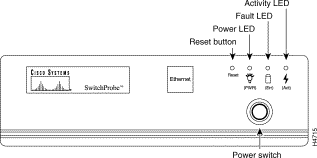
There are three LEDs on the front panel (Figure 3-1). Each LED indicates different information (Table 3-4). In SwitchProbe devices with multiple interfaces, the network activity LED indicates traffic on LAN interfaces.
| LED | Color | Status | Meaning |
|---|---|---|---|
Power | On | Indicates proper power supply to the device. This LED is normally on. | |
Fault | Off On or Blinking | Indicates the device is ready and working correctly. Indicates a hardware or software error in the device. | |
Activity | On | Indicates heavy network traffic. |
Before it boots, the device undergoes a series of self-tests when you power it up. During a normal boot or reset, you should see the following sequence:
Step 1 All LEDs come on at power up.
System diagnostics run for about 30 seconds.
Step 2 A short beeping sound signals that system diagnostics are complete.
Step 3 The agent sends status information to the user terminal if one is connected.
The fault (red) and network activity (amber) LEDs turn off briefly, then display the agent status as shown in Table 3-4.
To the left of the LEDs is a small pin hole (Figure 3-1). This pin hole provides access to the manual reset button. To manually reboot the device, insert a small object such as the tip of a pen and push inward. A slight press of the reset button reboots the SwitchProbe device.
Directly below the reset switch is a small toggle button that enables and disables power to the device. To toggle power on or off, press this button inward, then release it.
Table 3-5 lists the functions of the Power switch and the Reset button.
| This Switch... | Performs This Function |
|---|---|
Powers up the device. | |
The rear panel of the small chassis has two power sockets and multiple interface cards (Figure 3-2).
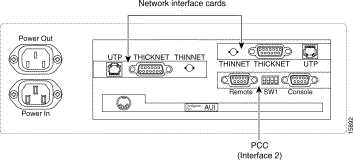
There are two power sockets on the back of the SwitchProbe device.
 | Caution To prevent damage to the device, never use the Power Out socket. |
Each device is equipped with an AC power cord for connection to an appropriate power source. To connect the device to a power source, see "Connecting a SwitchProbe Device to the Power Source" in "Installation."
Each SwitchProbe device contains one Peripheral Controller Card (PCC) and at least one Network Interface Card (NIC). In the small chassis SwitchProbe devices, these interfaces are located on the back panel of the device.
The PCC (which is always designated as interface 2) has three external components—A remote port, a console port, and DIP switches.
| Remote Port Setting | Specification |
|---|---|
Line rate | 9600 bps (default) |
Line code | ASYNC |
Line interface | EIA/TIA-232 |
No. of bits | 8 |
No. of stop bits | 1 |
Parity | None |
| Switch | Setting | Result |
|---|---|---|
1 | Off (default) | Boot from Flash memory |
2 |
| Reserved |
3, 4 | 3 = off | Console port = 1200 bps |
3 = off | Console port = 2400 bps | |
3 = on (default) | Console port = 9600 bps (default) | |
3 = on | Console port = 19200 bps |
Current models of SwitchProbe devices have the latest version of agent firmware loaded in both EPROM and FLASH memory. When a new version become available, you might need to upgrade the agent firmware. For more information, see "Upgrading Firmware" in "Configuration."
Because SwitchProbe devices boot from FLASH memory by default, all upgraded agent firmware is written to FLASH memory. Regardless of any upgrades you may perform, the original, factory-installed version of agent firmware remains in EPROM. Therefore, if the upgrade fails or the FLASH becomes corrupted, you can force the device to boot from EPROM by setting DIP switch 1 to on. The agent will boot from EPROM using the original firmware shipped with the device.
The small chassis series SwitchProbe devices contain a minimum of one NIC card, located in the back of the device. The number and topology the network interfaces vary according to the type of device.
SwitchProbe devices use network interfaces to receive network traffic, or to exchange management data with a management station—or to perform both tasks simultaneously. The task that a particular interface performs is determined by the interface's mode— Manage, Monitor, or Manage + Monitor.
Table 3-8 defines the SwitchProbe device interface modes.
| This Mode... | Performs This Function |
|---|---|
Exchanges (sends and receives) management data with an attached management station. | |
Receives network traffic for mapping statistical information into standard RMON-based counters. | |
Exchanges management data and receives network traffic simultaneously. |
Each interface in a SwitchProbe device is set to a default mode during manufacture. You can change the mode using the Agent Configuration Utility. For more information about each SwitchProbe's network interfaces, see "Network Connections."
Each interface in a SwitchProbe device is assigned an interface number. Because every SwitchProbe device has at least one network interface card and only one PCC interface card, Cisco Systems assigns interface 1 and interface 2 to these interfaces, respectively.
Interface 1 is always the default management interface. Depending on the model, this interface is either a Ethernet or Token Ring.
Interface 2 is always the SLIP port. This port is labeled Remote on the PCC interface card.
Cisco Systems offers two Ethernet SwitchProbe models:
Figure 3-3 shows the rear panel of the Single Interface Ethernet SwitchProbe device.

The Single Interface Ethernet SwitchProbe device contains one Ethernet network interface card. The default configuration of this interface—Manage + Monitor—allows the interface to monitor the traffic of an attached Ethernet segment and exchange (send and receive) commands with a management station.
Table 3-9 describes the interfaces of the Single Interface Ethernet SwitchProbe device.
| Interface Number | Interface Type | Connection Type | Default Interface Mode |
1 (top right) | Ethernet | Thinnet (10BASE2), Thicknet (10BASE5), or UTP (RJ-45) | Manage + Monitor |
2 | Serial | Remote (DB-9) port |
Figure 3-4 shows the rear panel of the Dual Interface Ethernet SwitchProbe device.
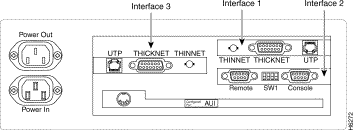
Table 3-10 describes the interfaces of the Dual Interface Ethernet SwitchProbe device.
| Interface Number | Interface Type | Connection Type | Default Interface Mode |
1 (top right) | Ethernet | Thinnet (10BASE2), Thicknet (10BASE5), or UTP (RJ-45) | Manage + Monitor |
2 | Serial | Remote (DB-9) port | Manage |
3 (top left) | Ethernet | Thinnet (10BASE2), Thicknet (10BASE5), or UTP (RJ-45) | Monitor |
Figure 3-5 shows the rear panel of the Token Ring SwitchProbe device.
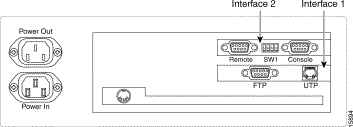
You can use the Agent Configuration Utility to change the configuration of the Token Ring interface only.
Table 3-11 describes the interfaces of the Token Ring SwitchProbe device.
| Interface Number | Interface Type | Connection Type | Default Interface Mode |
1 (lower right) | Token Ring (16 Mbps) | Foil Twisted Pair (RJ-45) or | Manage + Monitor |
2 | Serial | Remote (DB-9) port | Manage |
Figure 3-6 shows the rear panel of the Ethernet and Token Ring SwitchProbe device.

The Ethernet and Token Ring SwitchProbe device can monitor one attached Ethernet segment and one attached Token Ring segment. This device contains two network interface cards. Interface 1 is an Ethernet card, and interface 3 is a Token Ring card. Each network interface can monitor the traffic of an attached segment. The default configuration of interface 1—Manage + Monitor—allows that interface to also exchange (send and receive) commands with a management station.
Table 3-12 describes the interfaces of the Ethernet and Token Ring SwitchProbe device.
| Interface Number | Interface Type | Connection Type | Default Interface Mode |
1 (top right) | Ethernet | Thicknet (10BASE5), Thinnet (10BASE2), or UTP (RJ-45) | Manage + Monitor |
2 | Serial | Remote (DB-9) port | Manage |
3 (top left) | Token Ring | Foil Twisted Pair (RJ-45) or | Monitor |
Figure 3-7 shows the rear panel of the WAN and Ethernet SwitchProbe device.
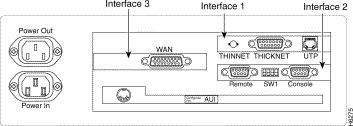
The WAN and Ethernet/Token Ring SwitchProbe device contains two network interface cards. Interface 1 is an Ethernet/Token Ring card, and interface 3 is a WAN card. Each network interface can monitor the traffic of an attached segment. The default configuration of Interface 1—Manage + Monitor—allows that interface to also exchange (send and receive) commands with a management station.
You can use the Agent Configuration Utility to change the configuration of the Ethernet interface only. The WAN interface is always in monitor mode.
Table 3-13 describes the interfaces of the WAN and Ethernet/Token Ring SwitchProbe device.
| Interface Number | Interface Type | Connection Type | Default Interface Mode |
1 (top right) | Ethernet/Token Ring | Thicknet (10BASE5), Thinnet (10BASE2), or UTP (RJ-45) | Manage + Monitor |
2 | Serial | Remote (DB-9) port | Manage |
3 (top left) | WAN | DB26 | Monitor |
The SwitchProbe devices in the front-access chassis measure 17 inches wide, by 16.5 inches deep, by 5.25 inches high (13.3 by 43.18 by 41.91 cm). They are housed in rack-mountable large chassis for mounting in a 19-inch equipment rack. This front-access chassis is also referred to as the PB8 chassis.
Unlike the small chassis—where the interfaces are accessed from the back of the device— the interfaces in the front-access chassis are accessed from the front of the device.
The front-access chassis series includes the following devices:
Figure 3-8 shows the front panel of a front-access chassis SwitchProbe device.

The four LEDs on the top left of the chassis front panel are described in Table 3-14.
| LED Label | Color | Status | Meaning |
|---|---|---|---|
POWER | Green | On | Proper power is being supplied to the device. This LED is normally on. |
Off | Proper power is not being supplied to the device. | ||
FAULT | Red | On or | Hardware or software error in the device. |
Off | Device is working correctly. | ||
|
| Reserved for future diagnostic use. | |
ACTIVITY | Amber | On | Indicates heavy network traffic. |
Blinking | Indicates moderate network traffic. | ||
Off | Indicates no network traffic. |
To the left of the LEDs is a small pin hole (Figure 3-8) that gives you access to the manual reset button. To manually reboot the device, insert a small object such as the tip of a pen, and push inward. A slight press of the reset button reboots the device.
Each SwitchProbe device contains one Peripheral Controller Card (PCC) interface card and at least one Network Interface Card (NIC). In the front-access SwitchProbe devices, these interfaces are located on the front panel of the device.
The PCC (which is always designated as interface 2) has three external components—A remote port, a console port, and DIP switches.
| Serial Port Setting | Specification |
|---|---|
Line rate | 9600 bps (default) |
Line code | ASYNC |
Line interface | EIA/TIA-232 |
No. of bits | 8 |
No. of stop bits | 1 |
Parity | None |
| Switch | Setting | Result |
|---|---|---|
1 | Off (default) | Boot from FLASH memory. |
2 |
| Reserved. |
3, 4 | 3 = off | Console port = 1200 bps |
3 = off | Console port = 2400 bps | |
3 = on (default) | Console port = 9600 bps (default) | |
3 = on | Console port = 19200 bps |
Current models of SwitchProbe devices have the latest version of agent firmware loaded in both EPROM and FLASH memory during manufacture. When upgrades become available, you might need to upgrade the agent firmware. For more information, see "Upgrading Firmware" in "Configuration."
Because SwitchProbe devices boot from FLASH memory by default, all upgraded agent firmware is written to FLASH memory. Regardless of any upgrades you might perform, the original, factory-installed version of agent firmware remains in EPROM. Therefore, if the upgrade fails or the FLASH becomes corrupted, you can force the SwitchProbe device to boot from EPROM by setting DIP switch 1 to on. The agent will boot from EPROM using the original firmware shipped with the device.
All NICs are positioned in the right front panel of the rack-mountable chassis. The amount and topology of the network interfaces will vary according to the model.
SwitchProbe devices use network interfaces to receive network traffic or to exchange management data with a management station, or to perform both tasks simultaneously. The task that a particular interface performs is determined by the interface's mode—Manage, Monitor, or Manage + Monitor.
Table 3-17 defines SwitchProbe device interface modes.
| This Mode... | Performs This Function |
|---|---|
Manage | Exchanges (sends and receives) management data with an attached management station. |
Monitor | Receives network traffic for mapping statistical information into standard RMON-based counters |
Manage + Monitor | Exchanges management data and receives network traffic simultaneously. |
Each interface is set to a default mode during manufacture. You can change the mode using the Agent Configuration Utility. For information about SwitchProbe device network interfaces, see "Network Connections."
Each interface in a SwitchProbe device is assigned an interface number. Because every SwitchProbe device has at least one network interface card and only one PCC interface card, Cisco Systems assigns interface 1 and interface 2 to these interfaces, respectively.
Interface 1 is always the default management interface. Depending on the model, this interface is either an Ethernet or Token Ring interface.
Interface 2 is always the Serial Line Internet Protocol (SLIP) port, and is labeled Remote on the PCC interface card.
Figure 3-9 shows the rear panel of the front-access chassis SwitchProbe device.

There are two power sockets on the back of the SwitchProbe device:
Each device is equipped with an AC power cord for connection to an appropriate power source. To connect the device to a power source, see "Connecting a SwitchProbe Device to the Power Source" in "Installation."
 | Caution To prevent damage to the device, and to ensure that it operates correctly, never use the Power Out socket. |
The power switch is in the upper right of the rear panel of the device. To turn on the power, press the (|) side of the button until it is flush with the rear panel. To turn off the power, press the (0) side of the button until it is flush with the rear panel.
 | Caution Before connecting the SwitchProbe device to the network, see "Site Requirements." |
Cisco Systems offers two Multiport Ethernet SwitchProbe models:
The four-port Ethernet SwitchProbe device contains three network interface cards as shown in Figure 3-10.

Each network interface can monitor the traffic of an attached segment. The default configuration of interface1—Manage—directs that interface to exchange (send and receive) commands with a management station.
Table 3-18 describes the interfaces of the four-port Ethernet SwitchProbe device.
| Interface Number | Interface Type | Connection Type | Default Interface Mode |
1 | Ethernet | Thicknet (10BASE5), Thinnet (10BASE2), or UTP (RJ-45) | Manage |
2 (right) | Serial | Remote (DB-9) port | Manage |
Interface 3 (port 1) | 10BaseT Ethernet | UTP (RJ-45) | Monitor |
The eight-port Ethernet SwitchProbe device contains five network interface cards, as shown in Figure 3-11.
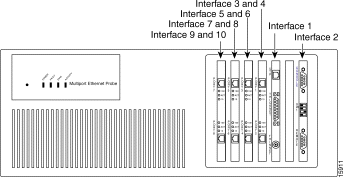
Each network interface can monitor the traffic of an attached segment. The default configuration of interface 1—Manage—directs that interface to exchange (send and receive) commands with a management station.
Table 3-19 describes the interfaces of the eight-port Ethernet SwitchProbe device.
| Interface Number | Interface Type | Connection Type | Default Interface Mode |
1 | Ethernet | Thicknet (10BASE5), Thinnet (10BASE2), or UTP (RJ-45) | Manage |
2 (right) | Serial | Remote (DB-9) port | Manage |
Interface 3 (port 1) | 10BaseT Ethernet | UTP (RJ-45) | Monitor |
Cisco Systems offers these Fast Ethernet SwitchProbe models:
Fast Ethernet Half-Duplex devices come in two models. The only difference between the models is the type of connector in the Fast Ethernet interface.
Figure 3-12 shows the Fast Ethernet Half-Duplex 100 Base TX SwitchProbe device.
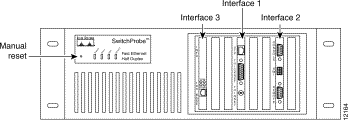
Figure 3-13 shows the Fast Ethernet Half-Duplex 100 Base FX SwitchProbe device. On this device, the RJ-45 connector on the Fast Ethernet interface card is replaced with a fiber-optic SC connector.
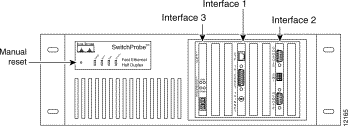
You can use the Agent Configuration Utility to change the configuration of the network interfaces; however, the device cannot support more than one network interface configured to manage mode.
Table 3-20 describes the interfaces of the Fast Ethernet Half-Duplex device.
| Interface Number | Interface Type | Connection Type | Default Interface Mode |
1 | Ethernet | Thicknet (10BASE5), Thinnet (10BASE2), or UTP (RJ-45) | Manage |
2 (right) | Serial | Remote (DB-9) port | Manage |
3 (left) | Fast Ethernet | Foil Twisted Pair (RJ-45) or UTP (RJ-45) for TX model | Monitor |
Fast Ethernet Dual Interface Half-Duplex SwitchProbe devices come in two models. The only difference between the two models is the type of connector in the Fast Ethernet interface.
Figure 3-14 shows the front panel of the Fast Ethernet Dual Interface Half-Duplex TX device.

Figure 3-15 shows the front panel of the Fast Ethernet Dual Interface Half-Duplex FX SwitchProbe device.
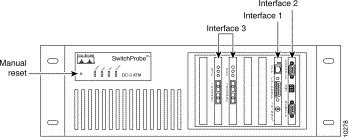
Each network interface in a Fast Ethernet Dual Interface half-duplex device can monitor the traffic of an attached segment. The default configuration of interface 1—Manage— directs that interface to exchange (send and receive) commands with a management station.
Table 3-21 describes the interfaces of the Fast Ethernet Dual Interface Half-Duplex SwitchProbe device.
| Interface Number | Interface Type | Connection Type | Default Interface Mode |
1 | Ethernet | Thicknet (10BASE5), Thinnet (10BASE2), or UTP (RJ-45) | Manage |
2 (right) | Serial | Remote (DB-9) port | Manage |
3 (left) | Fast Ethernet | Foil Twisted Pair (RJ-45) or UTP (RJ-45) for TX model or | Monitor |
4 | Fast Ethernet | Foil Twisted Pair (RJ-45) or UTP (RJ-45) for TX model or | Monitor |
Fast Ethernet Full-Duplex SwitchProbe devices come in two models. The only difference between the two models is the type of connector in the Fast Ethernet interface.
Figure 3-16 shows the front panel of the 100Base TX Fast Ethernet Full-Duplex SwitchProbe device.
A Fast Ethernet Full-Duplex SwitchProbe device has two Fast Ethernet interface cards—one for DTE and one for DCE.
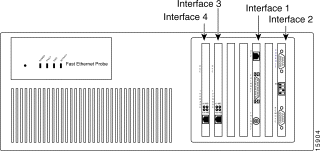
Figure 3-17 shows the front panel of the 100Base FX Fast Ethernet Full-Duplex SwitchProbe device.
A Fast Ethernet Full-Duplex SwitchProbe device has two Fast Ethernet interface cards— one for DTE and one for DCE.
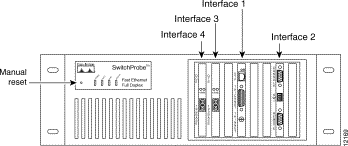
Each network interface in a Fast Ethernet Full-Duplex SwitchProbe device can monitor the traffic of an attached segment. The default configuration of interface 1—Manage—directs that interface to exchange (send and receive) commands with a management station.
You can use the Agent Configuration Utility to change the configuration of the standard 10 mbps Ethernet interface only. The Fast Ethernet interfaces are always in monitor mode.
Table 3-22 describes the interfaces of the Fast Ethernet Full-Duplex SwitchProbe device.
| Interface Number | Interface Type | Connection Type | Default Interface Mode |
1 | Ethernet | Thicknet (10BASE5), Thinnet (10BASE2), or UTP (RJ-45) | Manage |
2 (right) | Serial | Remote (DB-9) port | Manage |
3 | Fast Ethernet | Foil Twisted Pair (RJ-45) or UTP (RJ-45) for TX model or | Monitor |
4 | Fast Ethernet | Foil Twisted Pair (RJ-45) or UTP (RJ-45) for TX model or | Monitor |
Cisco Systems offers two Multiport Fast Ethernet SwitchProbe models:
Both models contain two Fast Ethernet interface cards with two ports on each interface card.
Figure 3-18 shows the front panel of the four-port Fast Ethernet TX SwitchProbe device.

Figure 3-19 shows the front panel of the four-port Fast Ethernet FX SwitchProbe device.
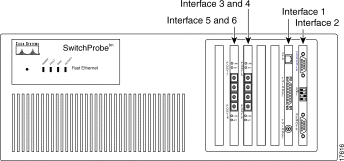
Each network interface in a Multiport Fast Ethernet SwitchProbe device can monitor the traffic of an attached segment. The default configuration of interface 1—Manage—directs that interface to exchange (send and receive) commands with an attached management station.
You can use the Agent Configuration Utility to change the configuration of the network interfaces; however, the device cannot support more than one network interface configured to manage mode.
You can also use the Agent Configuration Utility to configure the ports of the Fast Ethernet interfaces to one of the three monitoring modes:
Table 3-23 describes the interfaces of the four-port Fast Ethernet SwitchProbe device.
| Interface Number | Interface Type | Connection Type | Default Interface Mode |
1 | Ethernet | Thicknet (10BASE5), Thinnet (10BASE2), or UTP (RJ-45) | Manage |
2 (right) | Serial | Remote (DB-9) port | Manage |
Numbering depends upon the specific monitoring mode. | Fast Ethernet | UTP (RJ-45) for TX model or | Monitor |
| 1Requires one tap for each full-duplex interface. |
Cisco Systems offers two Fast EtherChannel SwitchProbe models:
The only difference between the two models is the type of connectors in the Fast Ethernet interface card—a TX connector or an FX connector.
Figure 3-20 shows the front panel of the Fast EtherChannel TX SwitchProbe device.
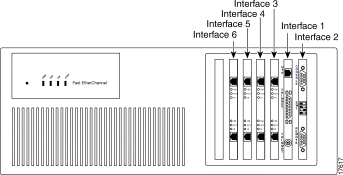
Figure 3-21 shows the front panel of the Fast EtherChannel FX SwitchProbe device.
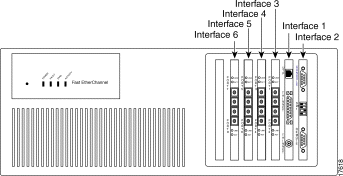
Each network interface in a Fast EtherChannel SwitchProbe device can monitor the traffic of an attached segment. The default configuration of interface 1—Manage—directs that interface to exchange (send and receive) commands with an attached management station.
You can use the Agent Configuration Utility to change the configuration of the network interfaces; however, the device cannot support more than one network interface configured to manage mode.
Table 3-24 describes the interfaces of the Fast EtherChannel SwitchProbe device.
| Interface Number | Interface Type | Connection Type | Default Interface Mode |
1 | Ethernet | Thicknet (10BASE5), Thinnet (10BASE2), or UTP (RJ-45) | Manage |
2 (right) | Serial | Remote (DB-9) port | Manage |
Full-Duplex | Fast Ethernet | UTP (RJ-45) for TX model or | Monitor |
| 1Requires one tap for each interface. |
The ports of the Fast EtherChannel SwitchProbe devices are fixed full-duplex ports. You cannot use the Agent Configuration Utility to change the mode of its ports.
Figure 3-22 shows the front panel of the FDDI DAS SwitchProbe device.
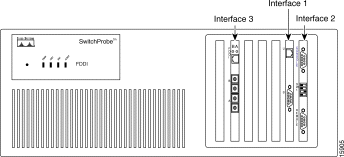
The FDDI DAS Ethernet SwitchProbe device contains two network interface cards. Interface 1 is an Ethernet card and Interface 3 is a FDDI DAS card. The default configuration of interface 1—Manage—directs that interface to exchange (send and receive) commands with a management station.
You can use the Agent Configuration Utility to change the configuration of interface 1 to also monitor.
Table 3-25 describes the interfaces of the FDDI DAS SwitchProbe device.
| interface Number | Interface Type | Connection Type | Default Interface Mode |
|---|---|---|---|
1 | Ethernet/Token Ring | Thicknet (10BASE5), Thinnet (10BASE2), or UTP (RJ-45) | Manage |
2 (right) | Serial | Remote (DB-9) port | Manage |
3 (left) | FDDI | Dual SC type (fiber optic) connectors | Monitor |
Figure 3-23 shows the front panel of the HSSI SwitchProbe device.

The HSSI SwitchProbe device contains two network interface cards. Interface 1 is an Ethernet card and Interface 3 is a HSSI card. Each network interface can monitor the traffic of an attached segment. The default configuration of interface 1—Manage—directs that interface to exchange (send and receive) commands with a management station.
You can use the Agent Configuration Utility to change the configuration of the Ethernet interface only. The HSSI interface is always in monitor mode.
Table 3-26 describes the interfaces of the HSSI SwitchProbe device.
| Interface Number | Interface Type | Connection Type | Default Interface Mode |
|---|---|---|---|
1 | Ethernet | Thicknet (10BASE5), Thinnet (10BASE2), or UTP (RJ4--5) | Manage |
2 (right) | Serial | Remote (DB-9) port | Manage |
3 (left) | HSSI | HSSI (DB-26) port | Monitor |
Cisco Systems offers two Multiport T1/E1 WAN SwitchProbe models:
The Multiport T1/E1 WAN SwitchProbe device can support a 6-MB inverse multiplexer (IMUX) connected to a single interface.
Each WAN interface can be configured to monitor traffic for its data-link connection identifier (DLCI) components. The SwitchProbe device can monitor up to 256 DLCIs aggregated from all interfaces. For example:
The two-port T1/E1 WAN SwitchProbe device contains three network interface cards:
Figure 3-24 shows the front panel of the two-port T1/E1 WAN SwitchProbe device.
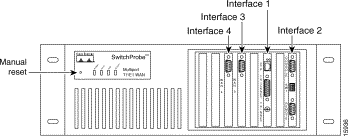
You can use the Agent Configuration Utility to change the configuration of the Ethernet interface only. The WAN interfaces are always in monitor mode.
Table 3-27 describes the interfaces of the two-port T1/E1 WAN SwitchProbe device.
| Interface Number | Interface Type | Connection Type | Default Interface Mode |
|---|---|---|---|
1 | Ethernet/Token Ring | Thicknet (10BASE5), Thinnet (10BASE2), or UTP (RJ-45) | Manage |
2 (right) | Serial | Remote (DB-9) port | Manage |
3 | WAN | (DB-26) port supports connections to V.35, X.21, RS-449, and EIA-530 | Monitor |
4 | WAN | (DB-26) port supports connections to V.35, X.21, RS-449, and EIA-530 | Monitor |
The four-port T1/E1 WAN SwitchProbe device contains five network interface cards:
Figure 3-25 shows the front panel of the four-port T1/E1 WAN SwitchProbe device.

Each network interface can monitor the traffic of an attached segment. The default configuration of interface 1—Manage—directs that interface to exchange (send and receive) commands with an attached management station.
You can use the Agent Configuration Utility to change the configuration of the Ethernet interface only. The WAN interfaces are always in monitor mode.
Table 3-28 describes the interfaces of the four-port T1/E1 WAN Ethernet/Token Ring SwitchProbe device.
| Interface Number | Interface Type | Connection Type | Default Interface Mode |
|---|---|---|---|
1 | Ethernet/Token Ring | Thicknet (10BASE5), Thinnet (10BASE2), or UTP (RJ-45) | Manage |
2 (right) | Serial | Remote (DB-9) port | Manage |
3 | WAN | (DB-26) port supports connections to V.35, X.21, RS-449, EIA-530 | Monitor |
4 | WAN | (DB-26) port supports connections to V.35, X.21, RS-449, EIA-530 | Monitor |
5 | WAN | (DB-26) port supports connections to V.35, X.21, RS-449, EIA-530 | Monitor |
6 | WAN | (DB-26) port supports connections to V.35, X.21, RS-449, EIA-530 | Monitor |
The ATM SwitchProbe device contains three network interface cards:
Figure 3-26 shows the front panel of the ATM SwitchProbe device.

Each network interface can monitor the traffic of an attached segment. The default configuration of interface 1—Manage—directs that interface to exchange (send and receive) commands with an attached management station.
You can use the Agent Configuration Utility to change the configuration of the Ethernet interface only. The ATM interface is always in monitor mode.
Table 3-29 describes the interfaces of the ATM SwitchProbe device.
| Interface Number | Interface Type | Connection Type | Default Interface Mode |
1 | Ethernet | Thicknet (10BASE5), Thinnet (10BASE2), or UTP (RJ-45) | Manage |
2 (right) | Serial | Remote (DB-9) port | Manage |
3 (left) | ATM | SC (one for DCE, one for DTE) | Monitor |
![]()
![]()
![]()
![]()
![]()
![]()
![]()
![]()
Posted: Wed Oct 2 08:33:15 PDT 2002
All contents are Copyright © 1992--2002 Cisco Systems, Inc. All rights reserved.
Important Notices and Privacy Statement.